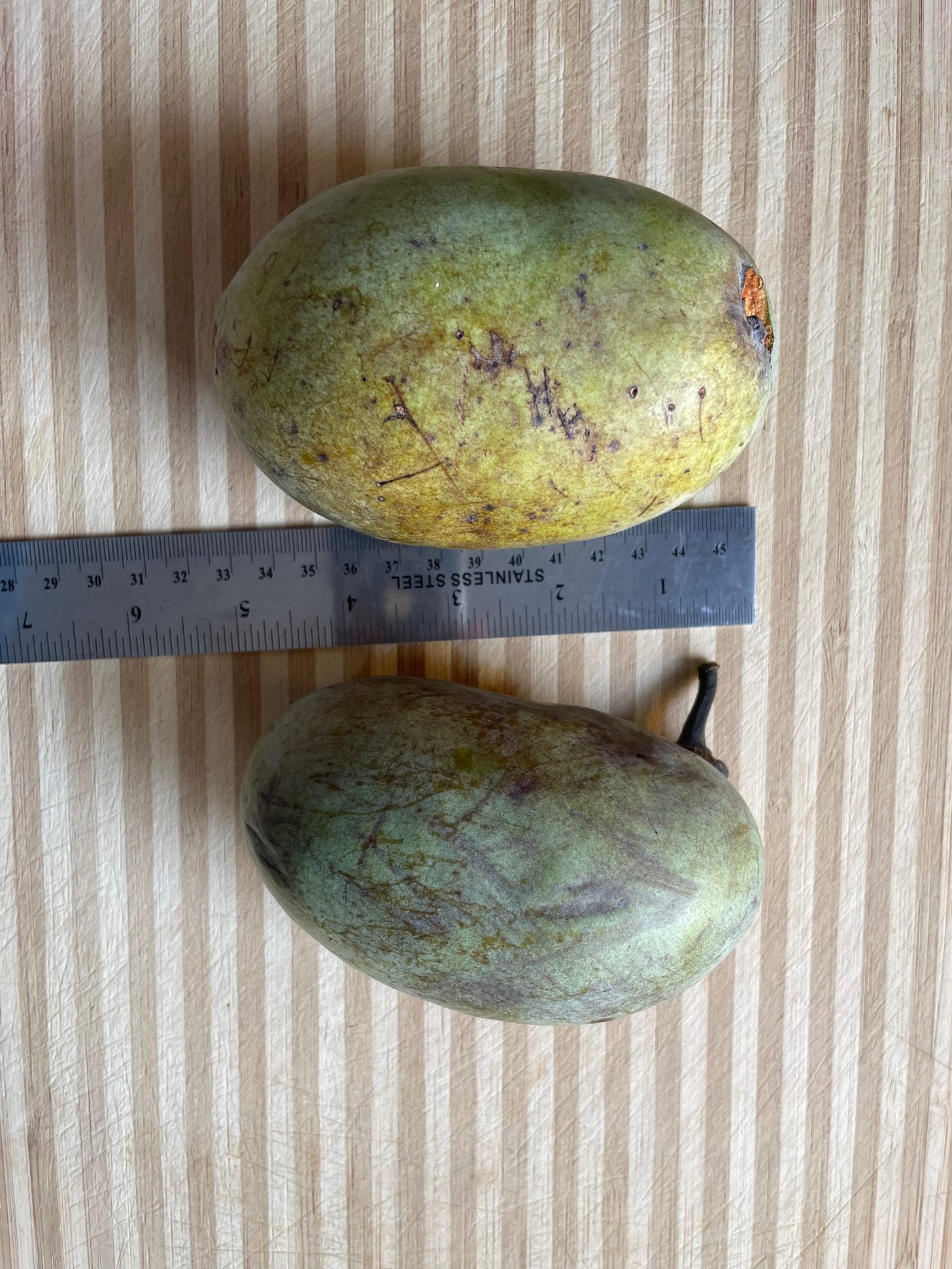We’re grabbing a fistful of the last days of summer at Weedom. Situation normal: we won’t finish everything that ought to be done, but will be replanting the fall/winter greenhouse, part of which was wiped out by some hungry creatures, affected by our drought. Soap is being produced and wrapped to sell at a series of Fall Festivals. The veggies and herbs are being harvested, and soon roots need to be dug up and dried. Some wild grapes which powered through the dry weather are ready if we can compete with the critters. Like many of our busy readers we live on a little farm with its attendant duties. So we celebrate the coming Fall season with an introduction to some tropical food that is hopefully within reach of many you right now: fruit of the American pawpaw tree, Asimina triloba.

This deciduous tree occupies much of the eastern U.S. and along the coast can grow as far north as Maine. Usual U.S. hardiness zones are 5a to 9b It’s often an understory tree, since the young plants do best in the shade, then reach for the sunlight, often becoming a tall, slender tree with leaves and fruit concentrated at the top. Only the Asimina genus of the tropical family, Annonaceae, occupies the temperate regions. Most of this “custard-apple” family grows in tropical regions far south of Midwest, U.S. flyover country, and this large, native fruit truly is an anomaly for our climate. If you mixed a lot of ripe banana and a little mango, that’s getting close to the paw paw fruit taste. It shares a texture somewhat between the two fruits, and like both, becomes sweeter when it gets softer and darker.

Groves of Paw Paw grew wild northwest of weedom, where your humble author was introduced to the joys of pharmacognosy. There the seeds were being investigated for anti-cancer potential, and yes, they have that attendant toxicity, so leave them behind and just feast on the indescribably delicious, pudding like yellow/orange innards of the fruit. Likewise, leave the skin behind too. Seeds and skin can cause intestinal issues as well as more serious, toxic troubles if eaten repeatedly. Some people can have skin sensitivity from contact with the fruit skins, and that would be a personal sign to proceed carefully with eating the interior. But for the vast majority, including yours truly, this fruit is a sign that the Creator loves us and wants us to have dessert.
The fruits seen above come from master gardener and apiarist, Mr. B. whom we hope to interview soon, for your listening pleasure. Among his trees is a variety of pawpaw called Overleese, which is known for large fruit and astonishing flavor.

Though we searched over the years, no pawpaw trees have been identified on weedom-land. Some landowners are naturally lucky, and some are not. So we ordered bare root trees and planted in the fall. After two failed attempts, we decided to plant from seed. We had some fruits shipped from eastern Ohio, where pawpaws are celebrated at summer’s end every year. They came well packed in newspaper, and slightly under ripe which was necessary for shipment. This fruit has not gone into mainstream commercial production because of the shipping characteristics, and likely the sometimes sporadic production habits. It also has a characteristic odor when very ripe, which won’t necessarily draw people to the fruit stand, although it’s not nearly as pungent as the legendary odor of delicious durian. :-D When a pawpaw is best to eat, the scent coming from the uncut fruit smells as though it is overripe. But once you cut into it, the odor of the innards is all tropical goodness. We let those shipped pawpaws ripen, ate some of them, froze some of them, and saved the seeds in some potting soil in the fridge. Then we planted the seeds in deep pots the following spring, and later replanted them among our trees south our abode. This has been successful, and we are now patiently waiting for our own crop. The trees, which represent at least 3 different cultivars, have begun to flower. This year the tallest tree is perhaps 12 or more feet high. Hopefully within a few more years we will harvest our own pawpaws.
Asimina triloba is a deep rooted tree, which drops leaves a bit earlier than our hardwoods. Some of you might begin seeing the large leaves shaped a little like the hickory tree, taking on a yellow fall hue. If you decide that you need your own pawpaw orchard, we suggest getting fruit from more than one source in your region, and planting the seeds in spring after cold stratification. While the pawpaw flowers have both male and female you need genetically distinct plants for cross pollination to get fruit. If you happen to see young pawpaws in a grove, they are likely clones of the older trees, emerging from their roots.
Lastly, you might likely find online information emphasizing cytotoxicity and neurotoxicity of members of the Annonaceae family, which includes our pawpaws. These troublesome compounds are concentrated in the seeds and skins of the fruit. Our readership has already seen and experienced numerous examples of edible plants, including those sold in grocery stores, which become toxic when eaten in huge quantity. Pawpaw is dessert, not the entire diet!! The healthiest people are experiencing a wide variety of foods in moderate quantities.

At weedom, we’re heading out into the sun, with prayers that our loyal readers experience a beautiful fall season, and a chance to taste those pawpaws or something just as delectable. As always, please feel free to share your experiences among the weeds, trees and mushrooms. Anyone can just add comments and questions to the latest thread in Chat, or Notes or Comments. We know that you have a lot to teach us, and each other too!!




